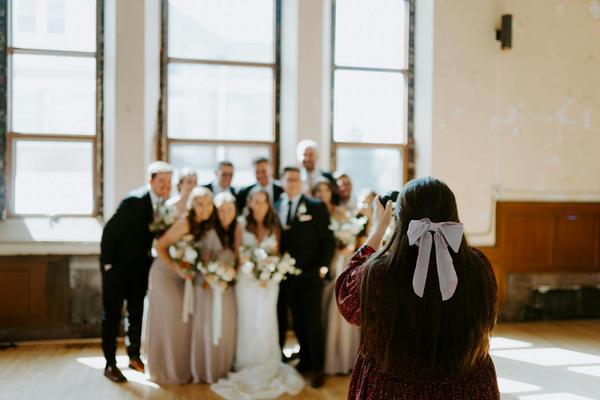
How to Become a Wedding Photographer in 10 Easy Steps

Jessica Michael
Published onLove photography? Love weddings? Want to become a professional wedding photographer but not sure how?
We've got you covered.
Follow these 10 steps to ignite your career as a successful wedding photographer. Let's get started!
Step 1: Get educated
If you are new to photography but are interested in becoming a wedding photographer, you'll want to learn everything you can about photography before you start.
From camera bodies and lenses to focal length and shutter speed, you'll need to familiarize yourself with the basics before you decide if photography is right for you. You'll also need to learn about how to do lighting and editing. Learning photography can be fun and challenging, and will help you decide what equipment and software to invest in as a beginner.
There are many photography courses offered online, but an in-person experience at a local community college or art and design school can be a better option for beginners. These courses offer hands-on experience and assistance from professional photographers.
If you are already a photographer but are looking to turn professional or pivot to wedding photography, an online course can be an excellent option. You can brush up the skills you specifically need for wedding photography, like managing indoor and outdoor lighting or how to put together an impactful wedding album.
Editing and using presets can be as important as the shoot, so check out courses that teach wedding photo editing or designing and using presets to give yourself a better understanding of how to optimize the photos you take.
Step 2: Attend a workshop
Consider attending one of the many wedding photography workshops that are offered around the world. More than likely, you'll be able to find one in your area and learn about the specific tips and techniques of wedding photography from a seasoned professional.
A workshop gives you a chance to learn wedding photography in a dynamic environment with other photographers. It also helps you build your portfolio by providing you a chance to work with models in staged shoots.
Check to see if any of your favorite wedding photographers from social media are hosting workshops. If you find a workshop you'd like to attend, check out the instructor's social media and wedding photography portfolio to make sure you respect their aesthetic.
Step 3: Set up styled shoots
Another way to build out your wedding photography samples is to sign up for a styled shoot.
Workshops are a wonderful way to learn how to shoot weddings, but they can be expensive and may not be necessary if you already have a handle on the techniques behind wedding photography. In that case, a styled shoot can be a great option as it allows you to build your portfolio quickly by providing an opportunity to shoot mock wedding scenes and photo opps.
There are a multitude of companies and photographers that offer styled shoots (check out Styled Shoots Across America), but you can also easily set up styled shoots of your own.
Choose a venue or location (or several, if you are able) and line up your models (if you have the budget, it's always great to work with professionals). Make sure you have a theme and a shot list to make the best use of your time. It can be beneficial to share costs with other photographers who share the same target demographic as you, but you can also do this own your own.
Styled shoots help you develop photography samples, refine your technique, and define your brand aesthetic, and you can make them as budget-friendly as you need to at each stage of your career.
Step 4: Reach out to other photographers
Rather than thinking of the other wedding photographers in your area as competition, it can be helpful to reframe them as allies or resources.
Get in touch with established wedding photographers to let them know who you are, what your professional experience is, and what kind of work you are looking for. It can help if you have an impactful portfolio that you can share with them so they can see your aesthetic and style (see Step 6 below).
If they are open to it, see if you can shadow them on some bookings. Offer to help out for free, and be open to lending a hand carrying gear or helping with set-up in exchange for the opportunity to be in the field. Shadowing gives you the chance to experience how a real wedding actually flows, which can be significantly different than a workshop or styled shoot.
In addition, successful wedding photographers are often booked far in advance and may not be able to take on new clients or clients with a shorter deadline. If they're impressed by your work and your work ethic, they may become a source of referrals for you, which is invaluable. Even if a photographer isn't open to having you shadow, they may still send referrals your way if you connect well with them.
Step 5: Get experience by being a second shooter
Many wedding photographers need a second shooter at weddings. So much is going on at once it can be hard for a single shooter to capture all of the most important moments, especially if it's a large or expensive affair.
Being a second shooter gives you the ultimate in-the-trenches experience of being a wedding photographer, plus you get to learn side-by-side from an experienced pro. Many photographers also allow second shooters to use the shots they take in their own portfolios and on social media as long as the original photographer is tagged, and the photos are posted after the original photographer posts their own. This differs from shoot to shoot, so guidelines on the specifics should be established beforehand.
A good second shooter is worth their weight in gold, so show up early, represent the brand of the photographer you are working with, and always be respectful that this is their gig not yours. There's a good chance you'll be invited back and set up a channel for future referrals from that photographer.
Step 6: Create your wedding photography portfolio
Your wedding photography portfolio website is your biggest marketing asset.
It's where you showcase your photography, define your services, and let people know more about you and your photography style. It's also where people can find your contact information and can reach out for a consultation.
It can be linked to your social media and used to capture potential clients' email addresses and contact info, and you can send your portfolio to anyone who might be interested in working with you or other businesses you'd like to network with.
In addition, many people find wedding photographers through Google, so having a portfolio site that's SEO-friendly so that you rank high on search pages is a must. And some portfolio hosting sites have templates that include a Blog page, which can also help with SEO and marketing.
Designing an impactful portfolio is key but it doesn't have to be hard. Portfolio building platforms like Journo Portfolio utilize easy-to-use drop-and-drag editors and pre-built templates that make it simple to get your portfolio up and running in hours, not weeks.
Once you've built your portfolio (check out our 9 Tips to Build a Professional Photography Portfolio), make sure to share it on social media, link it on your social media bios, and send it out to your email list and network. You'll also want to keep it updated with all your latest work so it becomes an evolving marketing tool for you as you grow.
Step 7: Get in touch with friends and family
Once you have your portfolio set up and have shared it on social media, make sure you let your loved ones know what you're doing and that you are looking for referrals. Send them a link to your portfolio so they can check out your photography and share it with anyone they know that might be getting married.
It can help to offer a friends and family discount at first (although be sure that you are still being paid fairly for your work---you don't work less just because you are being paid less). And don't be afraid to reach out directly to contacts you know who are planning a wedding, especially if you can offer them a fair price. Even if they don't take you up on it, it's a chance to get your name out there and engage your network in helping you build your business.
Step 8: Develop tiered wedding & engagement packages
A wedding package lets your client know exactly what they're getting when they hire you. It defines the number of shooting hours, the number of edited photos, prints and albums, and any extras like photo booths or drone coverage.
Most photographers create at least three wedding packages---a basic package, a mid-range, and a luxury package. This way, you can appeal to those on a limited budget all the way up to clients who want to pull out all the stops.
To figure out what to charge and what to include at each level, do some research into what other photographers who appeal to your demographic include at various price points. Remember, experience and reputation count, so if you're newer, you may need to charge less than more established photographers until your business grows.
It can also help to have a separate engagement package or to include one as an add-on to your wedding packages. If a couple uses you for their engagement photos, they're more likely to choose you for their wedding as well.
Step 9: Market your photography business
Once you're well-established, much of your business will come from word of mouth, but in the meantime, you'll need to learn how to market.
- Social Media Marketing
Social media is a particularly effective marketing channel for photography since it is such a visual medium. Instagram, Facebook and TikTok are useful. Aim to post 3 times a week, and take some time to learn hashtags and trends.
- SEO
Most clients look for wedding photographers who work in the area where the wedding is going to take place, and they use a Google search to do it. Learning SEO to get your wedding photography portfolio to rank higher on landing pages is well-worth the effort so that you can be one of the first websites they check out. Follow our complete SEO guide here.
- Advertising
Paid ads can be helpful, especially if you figure out how to target your ideal audience. Look for lifestyle magazines in your area to advertise in or partner with local businesses like florists and caterers to offer special discounts.
- In-person events
Many places hold wedding expos, which can be a great place to meet future clients. If there isn't one in your area, consider putting together a smaller expo in conjunction with other wedding-focused entrepreneurs.
- Organic outreach
Let people know you're in business. As we mentioned before, busy photographers are often looking for someone to refer to. In addition, there are many other types of businesses that target the wedding industry. Reach out to them and let them know who you are, what you do, and if there are ways that you can work together to benefit each other's businesses and clientele.
Step 10: Seek out media placements
Getting your wedding photography published in print or online can go a long way in establishing your brand and getting your photography in front of a wider audience.
Start by finding out which media platforms in your area run wedding photos and what their requirements are for submitting. Even if you don't get placed immediately, keep submitting until you do.
If you are trying to become a luxury or destination wedding photographer, look to larger national platforms like WedLuxe and Modern Luxury Magazine. These publications may be harder to get into but can put you in front of the right clients.
In addition, you may want to think beyond photos and reach out to local radio and newspapers, wedding podcasts, and blogs for interview opportunities. You can also write articles on your own blog (helpful for your site's SEO, too) or submit articles to other blogs and publications.
Gaining media traction is a long game, but it has the potential to introduce your work to clientele that wouldn't otherwise find you.
Conclusion
With patience and effort, you can create a successful and fulfilling career as a wedding photographer. If you're ready to explore creating a wedding photography portfolio, check out some examples of photography portfolios to get you inspired.




